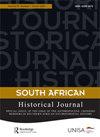1880年代至1928年夸祖鲁-纳塔尔州克兰斯科普的殖民入侵和恩扎马人的领导权之争
IF 1
3区 历史学
Q1 HISTORY
引用次数: 0
摘要
摘要恩扎马是一个独立的酋长国,但由于殖民地的分治策略,他们最终臣服于竞争对手恩古班酋长,恩古班首领随后纵容当地白人治安官任命他的儿子茨胡舒舒为他的继任者。这导致了恩扎马领导人和茨胡舒舒酋长之间的紧张关系。他们的分歧最终诉诸法庭,但白人当局站在了舒舒舒一边。Nzama和Ngubane之间的摩擦已经持续了几十年,但通常被简化为izimpi zemibango(派系斗争)一词,这是一个包罗万象的术语,未能解决冲突的根本原因及其长期历史根源。本文论述了1879年盎格鲁-祖鲁战争爆发前,纳塔尔殖民国家对克兰斯科普和格雷敦所在的乌图克拉河以南地区的干预,以强调战争后的变化。在这本书中,它探讨了Ngubane人和Nzama人受到的不同对待方式,这加剧了紧张局势,并为1880年代至1928年间爆发的izmpi zemibango埋下了种子。本文章由计算机程序翻译,如有差异,请以英文原文为准。
Colonial Intrusion and the Dispute over Leadership of the Nzama People in Kranskop, KwaZulu-Natal, 1880s to 1928
ABSTRACT The Nzama were an independent chiefdom, but because of the colonial divide-and-rule strategy, they ultimately were made subservient to the rival Ngubane chief, who then connived with the local white magistrate to install his son Tshutshutshu as his successor. This brewed tensions between the Nzama leaders and Chief Tshutshutshu. Their differences ended up in court, but the white authorities sided with Tshutshutshu. The friction between the Nzama and the Ngubane has continued for decades but is generally reduced to the term izimpi zemibango (faction fights), a catch-all term that fails to address the underlying causes of the conflict and its long historical roots. This article deals with the interventions by the Natal colonial state in the areas to the south of the uThukela River, where Kranskop and Greytown are located, before the outbreak of the Anglo-Zulu War in 1879 to highlight what changed after the war. Within this it explores the different ways in which the Ngubane and Nzama people were treated, which intensified tensions and held within it the seed for the outbreak of the izimpi zemibango between the 1880s and 1928.
求助全文
通过发布文献求助,成功后即可免费获取论文全文。
去求助
来源期刊

South African Historical Journal
Multiple-
CiteScore
0.70
自引率
0.00%
发文量
37
期刊介绍:
Over the past 40 years, the South African Historical Journal has become renowned and internationally regarded as a premier history journal published in South Africa, promoting significant historical scholarship on the country as well as the southern African region. The journal, which is linked to the Southern African Historical Society, has provided a high-quality medium for original thinking about South African history and has thus shaped - and continues to contribute towards defining - the historiography of the region.
 求助内容:
求助内容: 应助结果提醒方式:
应助结果提醒方式:


